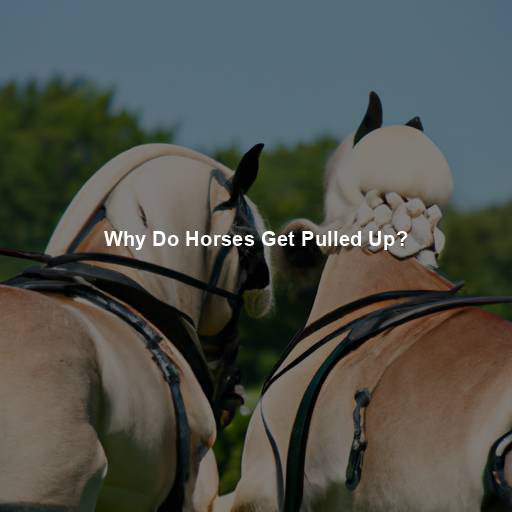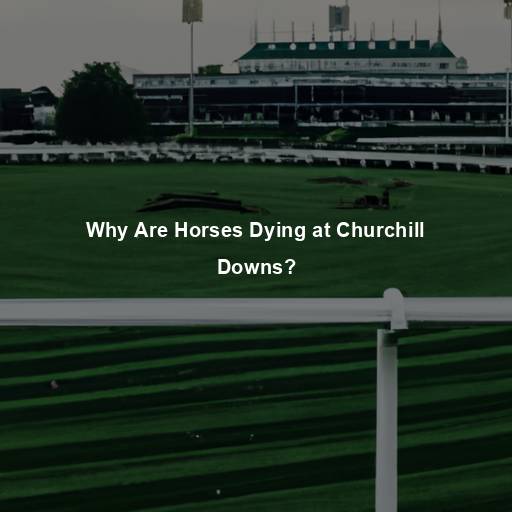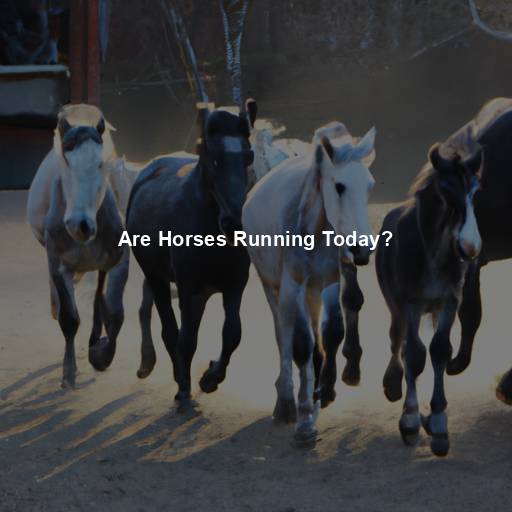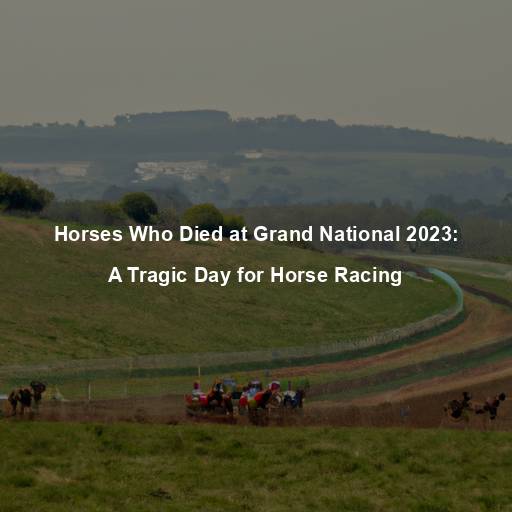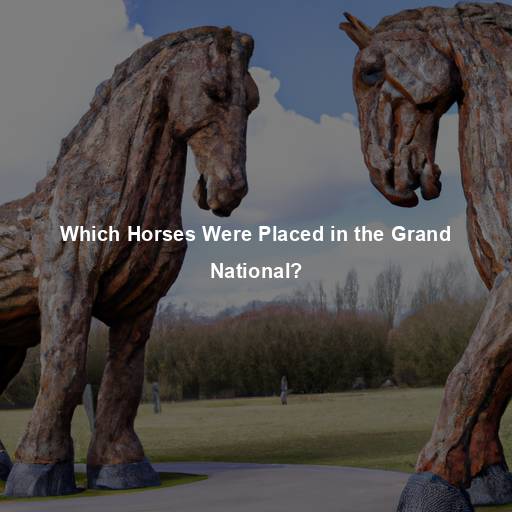Why Do Horses Get Pulled Up?
Last Updated on July 20, 2023 by Evan
Contents
- 1 Understanding the Phenomenon of Horses Being Pulled Up
- 1.1 Physical Injuries and Health Concerns
- 1.2 Equipment Malfunctions and Tack Issues
- 1.3 Behavioral Problems and Temperament
- 1.4 Track Conditions and Environmental Factors
- 1.5 Fatigue and Lack of Performance
- 1.6 Lack of Competitive Ability
- 1.7 Strategic Decisions and Future Considerations
- 1.8 Regulatory Measures and Safety Protocols
- 1.9 The Emotional Toll on Jockeys
- 1.10 The Repercussions for Owners and Trainers
- 1.11 Implications for the Future of the Horse
- 1.12 The Role of Veterinary Professionals
- 2 Promoting Horse Welfare in Racing
- 3 FAQs: Why do horses get pulled up?
- 3.1 Why do horses get pulled up during a race?
- 3.2 What are some signs that may lead to a horse being pulled up?
- 3.3 Can a horse be pulled up for behavioral reasons?
- 3.4 What happens to a horse after being pulled up?
- 3.5 Are there any restrictions or penalties for pulling up a horse?
- 3.6 Can a horse return to racing after being pulled up?
Understanding the Phenomenon of Horses Being Pulled Up
In the world of horse racing, the sight of a jockey pulling up a horse during a race can be both puzzling and concerning to spectators. It raises questions about the well-being of the horse, the reasons behind this action, and the potential implications for its future in the sport. To shed light on this phenomenon, we delve into the various factors that may lead to a horse being pulled up during a race. By exploring these reasons, we aim to gain a deeper understanding of this aspect of horse racing and the welfare of these magnificent creatures.
Physical Injuries and Health Concerns
One of the primary reasons why horses get pulled up during a race is due to physical injuries or health issues. Horses, like any other athlete, are susceptible to strains, sprains, or more severe injuries while competing. These injuries can occur suddenly or may be a result of underlying health conditions. When a jockey notices signs of distress, such as lameness, fatigue, or irregular breathing, they make the responsible decision to pull up the horse to prevent further harm.
Equipment Malfunctions and Tack Issues
There are numerous circumstances that can perplex and unsettle a horse during a race, prompting the jockey to abruptly pull them up. One such occurrence revolves around the effectiveness of the horse’s equipment, where unfortunate malfunctions or faults in their tack can disrupt their optimal performance. Just envision the dismay when a saddle abruptly starts to slip or a bridle unexpectedly snaps mid-race, causing the horse to lose control or feel immense discomfort. We must recognize that the well-being of both the horse and jockey is hanging by a thread in such perplexing situations, underscoring the urgent need to swiftly address any equipment issues that arise.
Behavioral Problems and Temperament
Horses, like humans, have individual personalities and temperaments. In some cases, behavioral problems or temperament issues can manifest during a race, leading to a jockey making the decision to pull up the horse. This can occur when a horse becomes excessively difficult to control, refuses to respond to cues, or exhibits dangerous behaviors. While training and conditioning play a crucial role in minimizing these issues, horses are sentient beings, and their behavior can be unpredictable at times.
Track Conditions and Environmental Factors
When it comes to horse racing, there are various factors that can lead to a jockey deciding to pull up their horse. The condition of the racetrack, along with the unpredictable elements of the environment, can create a sense of uncertainty and confusion. Whether it’s the relentless downpour of rain, the forceful gusts of wind, or the scorching heat, these extreme weather conditions can jeopardize the safety of both the horse and the rider. Additionally, factors such as slippery tracks, limited visibility, and uneven terrain can intensify the level of risk, raising concerns about potential accidents and injuries.
Fatigue and Lack of Performance
Horse racing is a demanding sport that requires exceptional athleticism and endurance from both the horse and the jockey. Just like humans, horses can experience fatigue or a decline in performance during a race. If a jockey notices that their horse is struggling, visibly tired, or not maintaining their pace, they may opt to pull up the horse to prevent overexertion or exacerbation of any underlying health issues. Taking into account the horse’s physical limits and ensuring its well-being is essential to maintain the integrity of the sport.
Lack of Competitive Ability
While every horse that participates in a race has undergone training and assessment, not all horses possess the competitive ability to excel in the demanding world of horse racing. Some horses may demonstrate limited potential or lack the necessary speed and stamina to compete against their counterparts effectively. In such cases, jockeys may decide to pull up the horse during the race rather than pushing them beyond their capabilities. Recognizing the individual strengths and limitations of each horse is crucial for their welfare and overall career trajectory.
Strategic Decisions and Future Considerations
During certain instances, jockeys are faced with perplexing choices that make them reconsider their approach on the racetrack. It’s a burst of unexpected twists and turns when a jockey, in a fickle moment, realizes that their equine companion is not in an ideal position to achieve greatness within the furlongs. Rather than continuing the laborious push in a desperate bid for victory, a wise jockey may opt to preserve the horse’s vitality and focus on future contests that hold a more promising outlook. Although these decisions may seem disheartening at first glance, they reflect the jockey’s commitment to the welfare and long-term aspirations of their equine partner.
Regulatory Measures and Safety Protocols
In the fascinating world of horse racing, it’s imperative to recognize that instances of horses being pulled up during races can often be attributed to the meticulous regulatory measures and safety protocols that define this thrilling sport. With the utmost commitment to the well-being and protection of all involved, the horse racing industry has established stringent guidelines and protocols. In some cases, if a horse falls short of performance expectations or exhibits signs of distress, jockeys are compelled to exercise caution and pull up the horse to avert any potential harm. These meticulous efforts are indispensable to both preserve the integrity of the sport and ensure the welfare of these majestic creatures.
In conclusion, the act of pulling up a horse during a race can be attributed to various factors ranging from physical injuries and health concerns to equipment malfunctions, behavioral issues, and strategic decisions. The welfare of the horse and the safety of the jockey and other participants are paramount considerations in these situations. By understanding the reasons behind horses being pulled up, we can ensure that the sport of horse racing continues to prioritize the well-being and longevity of these remarkable animals. ## Exploring the Impact of Pulling Up Horses
The Emotional Toll on Jockeys
The decision to pull up a horse during a race is not an easy one for jockeys. These skilled athletes develop deep connections with their equine partners and have a profound understanding of their capabilities and limitations. Pulling up a horse signifies a moment of disappointment and frustration for jockeys who strive for success in their races. It is a moment that challenges their resilience, as they question their strategies, tactics, and judgment.
The Repercussions for Owners and Trainers
Owners and trainers invest significant time, effort, and resources into preparing their horses for races. The decision to pull up a horse can have financial and emotional implications for them. From a financial standpoint, owners may lose out on potential prize money, sponsorships, or future breeding opportunities. Trainers, on the other hand, may face scrutiny and pressure from owners who expect positive results.
Implications for the Future of the Horse
When the thundering hooves come to a sudden halt during a pulse-racing horse race, a storm of uncertainty engulfs the air. Whispers of doubt swirl as questions about the equine athlete’s destiny loom large. Will they find the strength to rise from the ashes, mending their battered bodies and loyal spirits? Amidst this cloak of perplexity, wise owners, trainers, and jockeys bear the weight of making decisions that will shape the horse’s future.
The Role of Veterinary Professionals
The world of horse racing is dependent on veterinary professionals who possess a wealth of expertise that is indispensable when it comes to ensuring the overall health and well-being of the horses. These professionals play an essential role in diagnosing and treating injuries, as well as closely monitoring the horses’ health. Their guidance is not only valued by jockeys, owners, and trainers, but also vital in determining the cause behind a horse being pulled up during a race. With their expertise, they are able to assess the extent of the injury and identify any underlying health issues that may have contributed to the decision.
Promoting Horse Welfare in Racing
Stricter Regulations and Safety Measures
As the equestrian world gallops forward, ensuring the welfare of our majestic four-legged athletes has become a paramount concern. With a flurry of new regulations and safety measures, the racing industry is taking bold strides to minimize risks and prioritize the well-being of these magnificent creatures. Thorough inspections of racing facilities, track surfaces, and equipment keep a close eye on potential hazards, ensuring they are swiftly exorcised from the competitive arena. Additionally, stringent rules govern the fitness and eligibility of racehorses, guarding against any unnecessary dangers.
Investment in Research and Training
Advancements in veterinary medicine, training techniques, and horse care have significantly improved the welfare of horses in racing. Investment in research and development plays a vital role in identifying best practices, enhancing safety protocols, and improving the overall well-being of the horses. Researchers, veterinarians, and industry experts collaborate to explore topics such as injury prevention, racehorse nutrition, and psychological well-being. This ongoing commitment to education and knowledge-sharing contributes to the continuous improvement of horse welfare standards and the development of innovative solutions to address the challenges faced by the industry.
Raising Awareness and Education
Creating a safe and caring environment for horses in the racing world requires a collective effort from everyone involved. This means spreading knowledge and understanding to owners, trainers, jockeys, and spectators alike. By emphasizing responsible horse ownership, effective training techniques, and the importance of early intervention in maintaining their health, we can start to make a real difference. It’s crucial to nurture a culture of empathy within the racing community and actively engage with the public through various media channels, debunking myths and demonstrating our unwavering dedication to horse welfare.
Collaboration and Transparency
In the fast-paced world of horse racing, it is imperative that all those involved come together in a synchronized effort to protect the well-being of these majestic creatures. From the owners who hold the reins of responsibility, to the trainers who shape their abilities, the jockeys who guide them to victory, the regulatory bodies who provide oversight, and the veterinary professionals who tend to their health, a harmonious collaboration is integral. By creating an open channel of communication and sharing vital information about horse health, injuries, and performance, we gain a deeper understanding of the complexities within this industry. Embracing transparency when it comes to reporting injuries and incidents during races not only highlights the challenges faced, but also paves the way for targeted solutions.
FAQs: Why do horses get pulled up?
Why do horses get pulled up during a race?
Horses can be pulled up during a race for a variety of reasons. One common reason is if the jockey feels that the horse is not performing well or is in distress. In such cases, the jockey may choose to pull up the horse to prevent any further harm or injury. Additionally, if a horse loses a shoe or sustains an injury mid-race, the jockey may also opt to pull up the horse to avoid exacerbating the problem. The well-being and safety of the horse and rider are always a top priority.
What are some signs that may lead to a horse being pulled up?
There are several signs that may indicate the need to pull up a horse during a race. If a horse is visibly struggling, such as running erratically or lacking coordination, it could be a signal for the jockey to take action and pull up. Other signs may include the horse suddenly slowing down or experiencing lameness. It is important for the jockey to assess the situation quickly and make a decision in the best interest of the horse’s welfare.
Can a horse be pulled up for behavioral reasons?
In the realm of horse racing, the unexpected can gallop its way into the picture, leaving jockeys with no choice but to take a momentous decision. Picture this: a horse, a majestic creature known for its grace and agility, starts to showcase a side that can only be described as tempestuous. In the heart of the race, when stakes are high and tension hangs thick in the air, this horse becomes a wild card – difficult to control, perilously unpredictable. In such tumultuous moments, a jockey must consider not only the equine’s wellbeing, but also the safety of all participants, prompting the painstaking choice to pull up, thwarting disaster with bold resolve.
What happens to a horse after being pulled up?
When a horse is abruptly halted mid-race, it sets off a flurry of activity – a quick rendezvous with a discerning veterinarian to unravel the enigma of its condition and unveil any pressing concerns. Depending on the mysteries unraveled, the horse may be subjected to medical interventions in an attempt to resolve them. As the race dust settles, the horse ventures into a perplexing phase of repose and recuperation, affording its injuries the elusive chance to mend. A symphony of minds – the trainer, the owner, and the astute veterinary experts – meticulously orchestrate a convoluted dance of decision-making, fashioning a bespoke plan for rehabilitation.
Are there any restrictions or penalties for pulling up a horse?
When it comes to the intricate world of horse racing, the delicate balance between rider and equine is of paramount importance. Jockeys, in their noble pursuit of safety, hold the authority to gracefully pull up a horse during a race without facing retribution. Nevertheless, should a jockey display a disconcerting pattern of untimely withdrawals, fueled by questionable motives such as race manipulation, the guardians of fair play may be compelled to impose disciplinary measures. These measures, ranging from financial penalties to temporary or egregious bans, reflect the gravity of the offense committed.
Can a horse return to racing after being pulled up?
Whether a horse can return to racing after being pulled up depends on the reason behind being pulled up and the horse’s overall condition. If the horse was pulled up due to a minor issue or injury that can be resolved with proper rest and treatment, they may be able to resume racing once fully recovered. However, if the horse sustained a more severe injury or has recurring problems, retirement from racing may be the best option for its long-term well-being. Each case is assessed individually, taking into consideration the horse’s health and future prospects.

